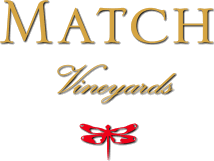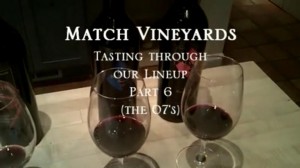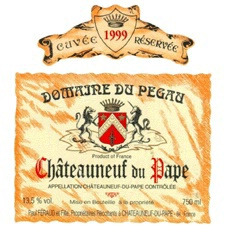 1999 Domaine du Pégaü Châteauneuf-du-Pape Cuvée Réservée – France, Rhône, Southern Rhône, Châteauneuf-du-Pape (1/7/2011)
1999 Domaine du Pégaü Châteauneuf-du-Pape Cuvée Réservée – France, Rhône, Southern Rhône, Châteauneuf-du-Pape (1/7/2011)
Lovely nose of dark fruits with grilled meat and charcoal. Full bodied with flavors of rum soaked cherries, wood smoke, bacon, and a hint of newly tanned leather. Excellent with just pop and pour. (92 points)
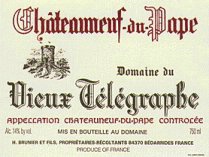 1999 Domaine du Vieux Télégraphe Châteauneuf-du-Pape La Crau – France, Rhône, Southern Rhône, Châteauneuf-du-Pape (1/7/2011)
1999 Domaine du Vieux Télégraphe Châteauneuf-du-Pape La Crau – France, Rhône, Southern Rhône, Châteauneuf-du-Pape (1/7/2011)
Way too young, tart, and tight… not expressing much at this time with just a pop and pour. Sour cherry and a bit of charred wood are peeking out now but my guess is this wine will improve dramatically with a few years and/or hours of air. Unfortunately, circumstances didn’t allow a decant. (88 points)
Posted from CellarTracker
- 1959 Château Pape Clément – France, Bordeaux, Graves, Pessac-Léognan
My late father-in-law appreciated fine Bordeaux and after his passing, my wife inherited several cases of his collection. This bottle was from that collection. Like most of the bottles, this was past its prime but an honor and a joy to drink it on the occasion of my wife’s birthday. We got to enjoy two gifts from Bob Match that night: my wife’s presence and a bottle from the past. Fill was just in to the neck. The cork was soaked and soft, but came out intact. Very light in weight, cedar with raspberry and pencil lead. The finish, while short, was of dried cooking spices. The wine quickly faded, but not before reminding us that wine is more than just a beverage to quench your thirst and satisfy our hedonistic side. Sometimes, it is memories in a bottle.
Posted from CellarTracker
Our winemaker, Cary Gott, wrote the following article with a generalized description of how one makes various wines. It’s sort of a what to expect from grape to bottle. You can download a PDF copy of this article here.
Wine Production Procedures for White and Red Wines
Cary Gott, Winemaker
Match Vineyards
This describes the winemaking steps for custom crush customers by wine style. Although each winemaker may have some unique techniques, generally this is how various wines are produced, the winemaking steps involved and their common names.
Also I give you some common production numbers we use to quantify production.
The wine styles explained
1. White wine, tank fermented and aged; Sauvignon Blanc & Pinot Grigio
2. White wine, barrel fermented and aged; Chardonnay
3. Rosé
4. Red wine, tank fermented and barrel aged; Cabernet Sauvignon, Zin or Syrah
5. Red wine, tank fermented and tank aged; Cabernet Sauvignon, Zin or Syrah
6. Red wine, barrel fermented and barrel aged; Cabernet Sauvignon, Zin or Syrah
1. White wine, tank fermented and tank aged then bottled
- Grapes are tested and tasted by the winemaker to determine when they are ready to pick
- Winemaker coordinates with winery and vineyard management to determine pick date
- Grapes are delivered to winery in 1/2 ton macro bins and placed out of the sun before processing
- Grapes are loaded into press for whole cluster pressing or destemmed and then pumped to the press
- Grapes are pressed and the juice is pumped to a SS (stainless steel) tank
- Juice is chilled to 50º to 60º F
- Juice is analyzed for the following items
o Brix, the approximate percent sugar, usually brix is 22º to 26º F
o pH
o TA, tartaric acid
o VA, volatile acidity
o YAN, yeast available nitrogen
- Juice is then adjusted for TA and pH if required by adding tartaric acid
- Juice is yeasted and has yeast food added to assist fermentation with DAP and Superfood
- The winemaker may want other fermentation items added to the juice
- In a day or two the juice starts to ferment and temperature is maintained at a constant temperature, usually about 60º F
- It will tank 2 to 3 weeks for the juice to ferment to dryness (dryness is about -1 brix)
- After the wine is dry SO2 is added to the wine based on the wine’s pH
- The winemaker may want to have the lees (yeast sediment on the bottom of the tank) stirred so as to add a mouth-filling soft texture to the wine
- The wine will be racked several times over the period of the next 4 to 6 months. Racking is pumping the wine from the tank to another tank leaving the lees on the bottom of the tank behind. The lees are discarded.
- While the wine is in the tank the free SO2 will be analyzed once a month. If it is too low more SO2 will be added. The amount of SO2 is usually based on the wine’s pH.
- About 45 days before bottling the winemaker & lab determines by analysis the heat and cold stability of the wine.
- If the wine is heat unstable bentonite is added to absorb proteins which could cause a haze in the wine once it is bottled.
- If the wine is cold unstable the wine will be chilled to 28º F for 3 weeks. That will cause tartrate crystals to form on the walls of the tank so they do not form when the wine is in bottle and in the consumer’s refrigerator.
- A few days before bottling the wine will be filtered to another tank and adjusted for sweetness if necessary.
- The wine will then be polish filtered just before bottling as it is being pumped to the bottling line bottle filler
- The bottles will be corked or screw-capped, tin capsules spun on (for cork finished bottles), labeled and put into cases. The cases will be palletized and shipped to the warehouse for aging.
2. White wine, barrel fermented and aged
- The juice production is the same up to the point of juice starting to ferment in the SS tank fermented description above
- Fermenting juice is chilled quite cold (say 50º F) and then pumped into new and used FO (French oak) barrels. Only a small amount of fermentation is complete before it is moved to barrels.
- Each 60 gallon barrel is filed to 50 gallons so there is head room for the fermentation foam that develops during barrel fermentation.
- The fermenting juice now ferments in about 2 weeks to dryness. While it ferments in oak barrels (new and used) it picks up character and style due to the barrels.
- The winemaker will determine if the wine (usually Chardonnay) is to have a malolactic (ML) fermentation. If so, ML bacteria is added to the wine. ML fermentation will take several weeks to complete. Malolactic fermentation is a bacterial fermentation of malic acid in wine.
- Once fermentation is complete the barrels will be topped from other barrels
- Every few weeks the barrels will be stirred with a lees stirrer to mix the lees (yeast cells) into the wine to add body and texture
- The barrels will have monthly free SO2 analysis and topping
- The following spring or summer the wine will be racked from barrels, heat and cold stabilized, filtered and then bottled.
3. Rosé
- Rosé is produced in a method that is similar to SS white wine but first there has to be some color in the juice that is produced from red grapes.
- There are three basic methods for obtaining juice with color:
o Whole clusters of red grapes (Syrah, Pinot Noir) are pressed and the resulting juice is a light rosé color
o Red grapes are crushed and put into the press or a tank to macerate for a few hours. The grapes are then pressed. This produces more color and flavor in the juice.
o Red grapes are crushed to tank and a fermentation is started. Once the fermentation starts the grapes are pressed. This produces a Rosé with substantial color and flavor
- Once the colored juice is obtained the rest of the processing is similar to white juice fermentation in SS
4. Red wine, tank fermented and barrel aged
- Ripe red grapes are destemmed and crushed. The must ( juice with skins and seeds ) is then pumped to a SS tank for fermentation. The tank is jacketed for cooling or heating to maintain proper fermentation temperatures.
- What follows is a typical Napa Valley Cabernet Sauvignon fermentation scenario . . .
- Once the must is in the fermenting tank an analysis of the juice is taken
- 35 ppm SO2 is added to the must
- Fermentation tannins and enzymes might also be added to the must. They help extract flavor and color.
- The must is chilled to a low temperature (50º to 55º) for a 3 to 5 day cold soaking period which allows water in the juice to extract color and flavor from the skins.
- During cold soaking the tank is pumped over two times per day to mix the skins and juice
- Pumping Over is the process of pumping the wine from the bottom valve on the tank to the top of the skins in the tank (the skins float on the juice/wine below). The floating skins are called the Cap.
- At the end of the cold soak period the tank is warmed up to 70º F.
- The tank is yeasted, yeast food is added as well as other red wine fermentation products to assist in the extraction of flavor and color from the skins
- The tank is pumped over 2 or 3 times per day during fermentation.
- Temperature is maintained to 80º to 85º F for proper fermentation.
- When the must is dry (-1 brix) the wine is drained out of the tank and put through a screen to remove seeds and skins and then pumped to another tank. This drained wine is called Freerun (as it ran freely out of the tank)
- The skins and seeds remaining in the tank (Pomace) is shoveled out of the tank and put in bins and then loaded into the press where any wine remaining in the skins is pressed out and put in another tank. That wine is called Press Wine. It may or may not be added back to the Freerun wine.
- ML bacteria will be added to the wine
- The new red wine will stay in the tank for a few days and then be racked to barrels.
- Once in barrels it will complete the ML fermentation in several weeks.
- Once ML complete the barrels will be racked off the lees to a tank where all of the barrels of that lots will be blended. The lees will be discarded.
- SO2 will be added to the new wine
- The wine will then be pumped back to barrel and the aging process of 15 to 20 months begins
- The barrels are topped at least once per month to keep them full, SO2 will be adjusted as necessary
- Every few months the barrels will be racked to tank, barrels cleaned and the pumped back
- When the wine is ready to bottle the wine will be filtered and bottled
5. Red wine, tank fermented and tank aged
- The fermentation technique for this is the same as above but after fermentation the wine stays in SS tanks and is processed with wood chips (to get oak flavors) and micro oxygen (micro ox) which duplicates the very slow oxygen pickup that wines obtains in barrel aging
- once the wine has obtained aging it is blended, filtered and bottled
- This method of aging is substantially less expensive than barrel aging and requires less time to produce bottle ready wines
6. Red wine, barrel fermented and barrel aged
- Currently in the trendy winemaking world this is the ultimate method to produce high-end award winning red wines (especially Cabernet and Syrah)
- New or used barrels have one head (the end of the barrel) removed and the red grape must is put in the barrel to ferment. The barrels are standing.
- Both regular size barrels (60 gallons) and larger puncheons (130+ gallons) are used for the barrel fermentation.
- The fermenting wine is Punched Down by hand to mix the skins with the wine. This is done several time per day.
- Once the fermentation is complete the barrels are dumped into the press and the wine is pumped to tank
- The next steps are the same as red wine fermented in SS tanks
Production numbers
– 1 ton = 160 gallons of wine
– 1 ton = 55 to 65 cases of wine
– 1 ton = 2.8 barrels
– 1 ton of red grapes requires 275 to 300 gallons of tank fermentation capacity for the cap and juice
– 1 barrel = 24 cases of bottled wine
– 1 case = 9 liters or 2.38 gallons
– 1 pallet of bottled cases is usually 56 cases
- 2004 Castello di Amorosa Cabernet Sauvignon – USA, California, Napa Valley (12/6/2010)
Fine, though not remarkable Cab, with currant, cedar, and mint with light mouthfeel and rather short finish. Drink now. (84 points) - 2005 A Donkey and Goat Syrah Broken Leg Vineyard – USA, California, North Coast, Anderson Valley (12/6/2010)
Perception of extremely high alcohol aroma and taste. Out of balance. Cherry cough syrup flavor. (74 points) - 2007 Le Cadeau Pinot Noir Rocheux – USA, Oregon, Willamette Valley (11/4/2010)
Tart strawberry with cedar. Too early to drink, but going to be an excellent Pinot. - 1996 Joseph Phelps Cabernet Sauvignon Backus – USA, California, Napa Valley, Oakville (10/12/2010)
Excellent. Drink now. - 1998 Panther Creek Pinot Noir Freedom Hill – USA, Oregon, Willamette Valley (9/30/2010)
A little “long in tooth”. This wine’s best day’s are behind it. Sour cherry, sage, thin finish. (87 points) - 2006 Milat Merlot Estate Bottled – USA, California, Napa Valley, St. Helena (9/16/2010)
Light bodied with pleasant strawberry. Eucalyptus flavor had a sharp edge approaching medicinal. Simple, but nice weekday wine. (83 points)
Posted from CellarTracker
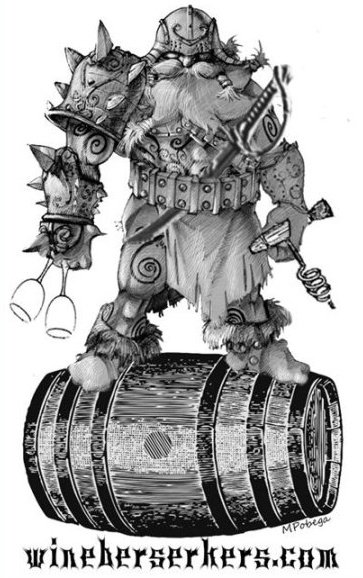 The second annual Berserker Day is being celebrated at Wineberserkers.com. This online community is a place where thousands of folks slightly (or very) berserk over wine gather to discuss this passion.
The second annual Berserker Day is being celebrated at Wineberserkers.com. This online community is a place where thousands of folks slightly (or very) berserk over wine gather to discuss this passion.
In honor of Berserker Day, over 60 special deals, raffles, and auctions are being offered by the member wineries, retailers, and individuals of the forum.
If you want to discover some new wines at some very attractive prices, check it out. (I believe you will have to register with WineBerserkers in order to see the deals.)
By the way, our offer on the forum is we will be raffling off 6 magnums of the soon-to-be-released 2008 Butterdragon. To be eligible, you’ll have to be a member of Wine Berserkers and have donated the retail value of the wine ($135) to a children’s health charity from Jan 1 – Jan 27, 2011. Our recommended charity is the Children’s Tumor Foundation.
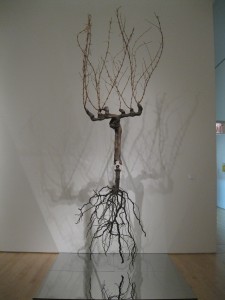 SFMOMA | Exhibitions + Events | Calendar | How Wine Became Modern: Design + Wine 1976 to Now.
SFMOMA | Exhibitions + Events | Calendar | How Wine Became Modern: Design + Wine 1976 to Now.
We went to this last night. It was okay, but a pretty small exhibit. It would be worth stopping in on that floor if you are going to SFMOMA anyway but probably not worth a special trip.
I heard several folks saying what we were thinking: they should have a wine tasting at the end of the exhibit.
One Wednesday, January 19, 2011 we bottled approximately 150 cases of our ’08 Baconbrook Cabernet. This wine will be released in the Fall. Here’s the video. Sorry for some of the sound quality. It’s loud on those bottling trucks.
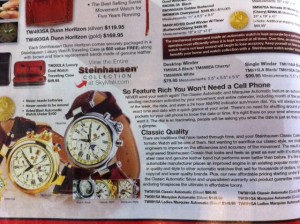 I just had to chuckle. That’s how the ad in the SKY MALL catalog described a technological marvel that is “so feature rich you won’t need a cell phone.” It doesn’t make calls, text, or email, but “there’s no need to shuffle around your pockets for your cell phone to know the date and time. It’s right there on your wrist whenever you want it.” I guess marketing in today’s interconnected world requires new verbiage to sell a watch.
I just had to chuckle. That’s how the ad in the SKY MALL catalog described a technological marvel that is “so feature rich you won’t need a cell phone.” It doesn’t make calls, text, or email, but “there’s no need to shuffle around your pockets for your cell phone to know the date and time. It’s right there on your wrist whenever you want it.” I guess marketing in today’s interconnected world requires new verbiage to sell a watch.
